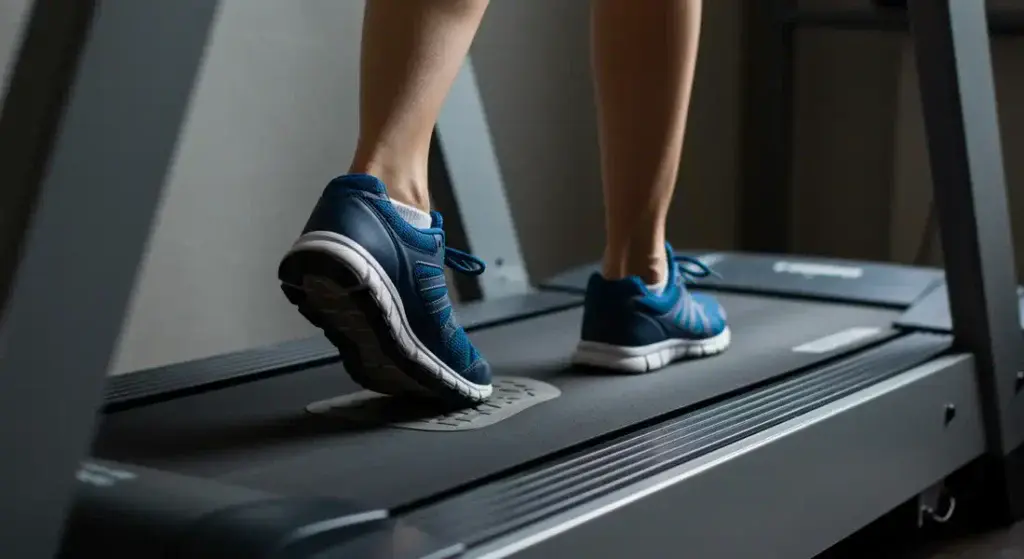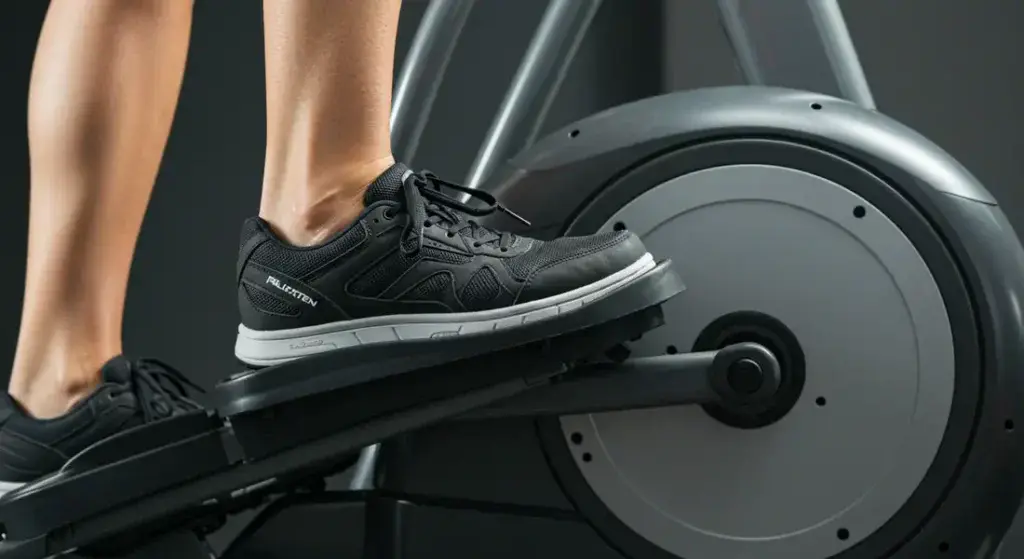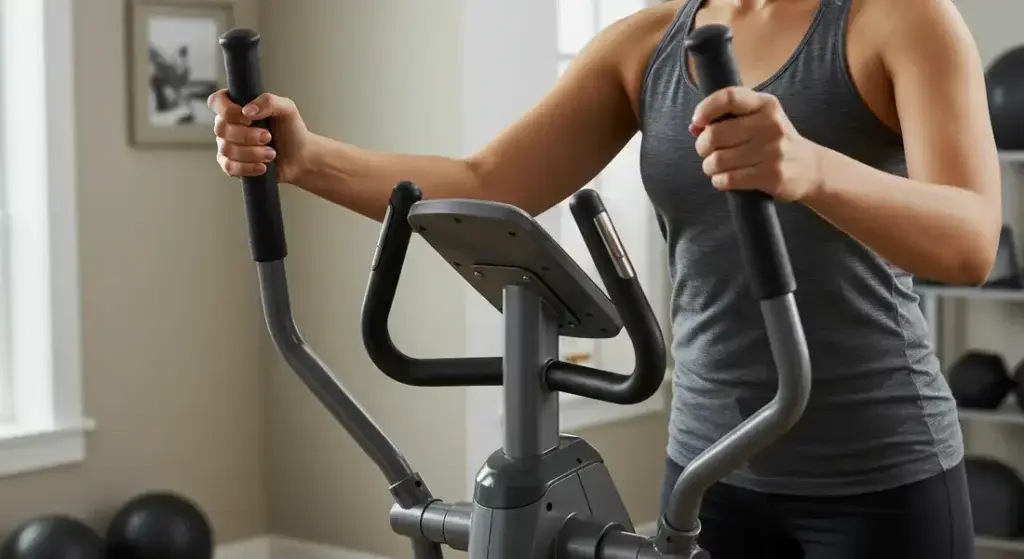So, you’re ready to bring cardio workouts into your home – fantastic! But now you face the classic dilemma – Treadmill or Elliptical?

Both are incredibly popular, effective machines, and seeing them side-by-side can leave any beginner feeling confused about which path to take.
Which one is truly better… for you?
Forget trying to find a single “winner.” Think of this guide as your personal Cardio Matchmaker.
We’re not here to declare one superior; we’re here to help you decide by walking through the key differences and asking the right questions based on your body, your fitness goals right now, and your personal preferences.
This comparison builds on the basics covered in our Ultimate Beginner’s Guide to Treadmills, applying similar thinking to help you find your perfect cardio partner. Let’s find your fit!
First, What Are We Comparing? The Core Difference in a Nutshell
Before we dive into matchmaking, let’s quickly define our contenders:
- The Treadmill: Features a moving belt that simulates walking, jogging, or running. You set the speed and incline (on motorized models), and your body works against gravity, providing the propulsion just like moving over ground.
- The Elliptical: Has foot pedals that move in a smooth, elliptical (oval) path – forward or sometimes backward. Your feet typically stay planted on the pedals throughout the motion. Resistance levels are adjustable, and many models include moving handlebars to engage the upper body.
The Key Distinction for Beginners: The most fundamental difference lies in the impact. Treadmills involve the natural impact of your feet hitting the deck (though cushioning helps!), while ellipticals offer a gliding, very low-to-no impact motion.
This difference often becomes the deciding factor.
The Matchmaking Process – Key Questions to Ask Yourself
Ready to find your match? Let’s explore the crucial factors for beginners by asking some key questions:
Question 1 – How Do Your Joints Feel? (Impact Tolerance)

- Why it Matters: This is often the #1 consideration for beginners, especially if you have existing knee, hip, ankle, or back sensitivities. Starting comfortably is key to sticking with it!
- Treadmill Profile: Offers a higher impact experience (though significantly less than road running thanks to deck cushioning). This impact can be beneficial for building bone density, if your joints can handle it comfortably. However, it can potentially aggravate pre-existing joint pain.
- Elliptical Profile: Famous for its very low-impact nature. Because your feet stay connected to the pedals, the jarring stress on joints is minimal. This makes it a go-to choice for many people with arthritis or those recovering from certain injuries.
- Your Matchmaking Clue: If you experience regular joint pain or have conditions like arthritis, the Elliptical is likely your safer, more comfortable starting point. If your joints feel generally healthy and you appreciate the bone-strengthening benefits of impact exercise, the Treadmill remains a top contender.

Question 2 – What’s Your Primary Fitness Goal (Right Now)?
- Why it Matters: While both provide excellent cardiovascular workouts, there are slight nuances depending on your main objective as a beginner.
- Goal: Improve General Cardiovascular Health: Both are fantastic! Consistent use of either machine at a moderate intensity will strengthen your heart and lungs effectively. Consider this a Tie – choose based on other factors.
- Goal: Weight Loss: Both are effective calorie burners, contributing to the calorie deficit needed for weight loss (when combined with diet). Some studies suggest treadmills might burn slightly more calories at the exact same perceived effort due to supporting full body weight against impact. However, many people find they can exercise longer or at a higher sustainable intensity on an elliptical because it feels less strenuous due to lower impact. Consistency is king here. Verdict: Largely a Tie, heavily dependent on how you use the machine.
- Goal: Tone & Strengthen Lower Body: The Treadmill closely mimics natural walking/running, directly engaging calves, quads, hamstrings, and glutes in a functional way, especially with incline. The Elliptical also works these muscles effectively, and adding resistance increases the challenge, but the fixed pedal path might feel slightly less targeted for functional strength compared to free movement on a treadmill for some users. Slight edge: Treadmill.
- Goal: Get an Upper Body Workout Too: The Elliptical (with moving handlebars) is the clear winner. Actively pushing and pulling the handles engages your arms, shoulders, chest, and back, providing a more comprehensive full-body workout in one session. Treadmill workouts are primarily lower-body focused.
- Your Matchmaking Clue: For heart health or weight loss, either works well with consistent effort. If engaging your upper body simultaneously is appealing, lean Elliptical. If functional leg strengthening mimicking real-world movement is key, lean Treadmill.

Question 3 – What Kind of Movement Feels Better or More Natural to You?
- Why it Matters: If you don’t enjoy the feel of the movement, you’re less likely to stick with it! Comfort and preference are huge factors in long-term success.
- Treadmill Profile: Replicates the universally familiar actions of walking and running. The learning curve for the basic movement is practically zero. It feels functional and directly translates to activities outside the home.
- Elliptical Profile: Offers a smooth, gliding motion that’s unique. Some people love this fluid feeling instantly, finding it almost effortless. Others might find the fixed elliptical path feels slightly unnatural or restrictive at first compared to free-form walking.
- Your Matchmaking Clue: If you enjoy walking or running and want that familiar ground-contact feel, the Treadmill is a natural fit. If you prefer a smooth, floating sensation and dislike the feeling of impact, the Elliptical might feel much more comfortable and appealing. Trying both machines briefly in a store or gym, if possible, is the absolute best way to gauge your personal preference.
Question 4 – How Important is Workout Variety (and What Kind)?
- Why it Matters: Doing the exact same thing every day can lead to boredom. Both machines offer ways to mix things up.
- Treadmill Profile: Variety comes primarily from manipulating speed (from slow walks to sprints) and incline (simulating flat roads to steep hills). This allows for steady-state workouts, hill climbs, and various types of interval training.
- Elliptical Profile: Variety comes from adjusting resistance (making it harder/easier to pedal), changing ramp incline (on models that offer it, altering the stride path and muscle focus), pedaling forwards or backwards (works muscles slightly differently), and shifting your effort focus between legs and arms.
- Your Matchmaking Clue: Both provide good options for variety. If you like the idea of simulating different outdoor terrains through speed and incline changes, the Treadmill excels. If you enjoy playing with resistance levels, changing pedal direction, and varying upper/lower body engagement, the Elliptical offers diverse possibilities.
Quick Comparison Cheat Sheet – Treadmill vs. Elliptical for Beginners
| Feature | Treadmill | Elliptical (with Handles) |
| Impact Level | Higher (Cushioning Helps) | Very Low / Non-Impact |
| Primary Muscles Worked | Legs, Glutes, Core | Legs, Glutes, Core + Arms, Chest, Back |
| Movement Feel | Natural Walking/Running Simulation | Smooth, Gliding Motion |
| Key Beginner Advantage | Familiar Motion, Bone Density Benefit | Joint-Friendly, Full Body Option |
| Potential Beginner Drawback | Can Aggravate Sore Joints | Motion Can Feel Less Natural Initially |
Key Takeaways – Your Quick Decision Guide
- Joint Pain? Elliptical is generally the safer, more comfortable starting point.
- Want Upper Body Too? Elliptical with moving handles offers a full-body workout.
- Love Walking/Running Feel? Treadmill provides the most natural simulation.
- Bone Density Important? Treadmill’s impact (if tolerated) offers benefits.
- Weight Loss/Cardio Goal? Both are effective – choose based on comfort, enjoyment, and consistency potential.
- Try Before You Buy (if possible): Personal feel is often the deciding factor!
The Matchmaker’s Verdict – Which Way Should You Lean?
Based on your answers to the questions above, here’s a summary to help guide your decision:
- Lean Towards the TREADMILL if:
- You have generally healthy joints that tolerate moderate impact well.
- Your main goal is to simulate outdoor walking, jogging, or running.
- You value the potential bone density benefits of impact exercise.
- You prefer the familiar, functional feel of walking/running.
- Lean Towards the ELLIPTICAL if:
- You need a very low-impact workout due to joint pain, sensitivity, or preference.
- You want the option to actively engage your upper body for a more total-body workout.
- You prefer a smooth, gliding sensation over ground impact.
- It’s Likely a TIE (Go with Your Gut or Try Them Out!) if:
- Your primary goal is general heart health or supporting weight loss (and you’ll use either consistently).
- You don’t have significant joint issues making impact a major concern.
- Neither movement type feels particularly better or worse to you after consideration (or a trial).
Frequently Asked Questions (FAQ)
- Q1: Which machine burns more belly fat?
- A: Neither machine can “spot reduce” belly fat specifically. Fat loss occurs overall when you burn more calories than you consume. Both treadmills and ellipticals help burn calories effectively. Choose the machine you’ll use most consistently and combine it with a healthy diet for best results.
- Q2: Is the elliptical easier for beginners than the treadmill?
- A: It can feel easier for some due to the lower impact and perceived exertion. However, the movement pattern of walking on a treadmill is often more intuitive initially. “Easier” depends on your definition – less joint stress (elliptical) or more familiar movement (treadmill).
- Q3: Can I get a good workout just by walking on a treadmill?
- A: Absolutely! Brisk walking, especially incorporating incline, is an excellent cardiovascular workout for beginners and beyond. Don’t feel pressured to run if walking feels better for you.
- Q4: Do I need moving handlebars on an elliptical?
- A: You don’t need them, but they are required to get the upper body workout benefit. If you only use the stationary handles, it becomes primarily a lower-body exercise, similar in muscle focus (but lower impact) to a treadmill or exercise bike.
Conclusion
Choosing between a treadmill and an elliptical as a beginner doesn’t have to be stressful. There’s no single “right” answer – only the answer that’s right for you.
By honestly assessing your joint health, primary fitness goals, how you like to move, and the kind of variety you prefer, you’ve used this “Cardio Matchmaker” guide to gain clarity.
Trust your assessment!
The most effective cardio machine is ultimately the one you feel comfortable using, enjoy enough to use consistently, and can operate safely.
That consistency is what will truly drive your fitness results.
Ready to take the next step based on your match?
Leaning Treadmill? Dive deeper into the specifics with our Ultimate Beginner’s Guide to Treadmills.
Want to know what features to look for? Explore our Key Treadmill Features Explained guide.
Excited to plan your first sessions? Check out Simple Treadmill Workouts for Beginners.
More Comparison between Elliptical Vs. Treadmill Vs. Stationary Bike
